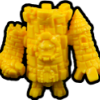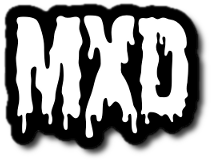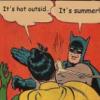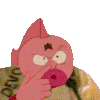MUSCLE Buying Guide
#1
 Guest_General Veers_*
Guest_General Veers_*
Posted 15 September 2008 - 12:25 PM
I wanted to create something for MUSCLE collectors that they can use as a reference when buying figures. I wanted to have a picture of the figure, plus a ranking for each color. I figured I could use my needs list, the MUSCLE DB, Soupie's CIA, and common knowledge to put something halfway decent together. I figured there are like 50 legitimately hard to find figures, plus 5 or 6 really desirable figures – and it might be good for the board.
I don't believe a fair buying guide like this can be constructed for a few reasons:
1. There aren’t rare MUSCLE figures
It seems counter intuitive to the difficulty I've faced finding the last ~50 figures I need. But I think it has everything to do with accessibility not scarcity. I contacted a friend who had played a good amount of hockey (juniors, OHL, etc.) and asked him to email some of his Canadian friends. Sure enough, the guy from western Canada had figures I needed. That's just too easy. If they were rare, only some people in Western Canada should have the "rare" figures. But based on my experience, and every valid western Canada auction, those "rare" figures are just figures there. Accessibility, not scarcity, is the problem.
2. Sellers
This is a broad topic, but it falls into two camps: (1) don't care; and (2) care too much. The first group has these figures in their attics, basements, and storage units. But because MUSCLE isn't a popular, or even moderately well-known, property these sellers don't know they could sell these figures for decent money. The second group thinks they have the plastic equivalent to gold. Based on our little community the figures have been elevated to absurd heights. A Purple Claw is arguably more valuable than a Flesh Claw, but is it 500% more valuable? Probably not. But what about a Light Blue #31? As a flesh figure it's probably worth no more than $1. What would the figure be worth in the open market? It is not popular. The figure holds value to only two groups of people: (1) collectors of only one color – of which I know none; and (2) people going for a complete color set – of which I know a handful. After those handful of collectors find it, nobody wants the figure and it has lost all of its value.
3. Data changes
People manipulate the MUSCLEDB – accidentally, intentionally, and even angrily. The population using this database is too small to be representative. The color tree data is interesting, but very broad, and complete speculation. Basing hard numbers on very soft, ever changing data is asking for laborious and continuous updates.
But I still want to provide new collectors with guidelines. I want to protect the hobby from scammers and vultures. So how do we create a usable, in-depth, fair, buying guide?
#2

Posted 15 September 2008 - 01:07 PM
The popularity of the game would have to nearly go extinct for a while. At the moment everyone who collects muscles, via internet access, have been ingrained with the absurd notion that certain figures are worth mountains of money because the knowledge wasn't completely there, and what small knowledge of scarcity we had was, infact, very small.
Arforbes tactfully controlled the color figure and Super Rare market for years, whether intentional or not, he did it, and still sells his "EXTRA" Super Rare colored figs at ridiculous prices on eBay.
People are still overpaying for SatanCross, even though the information on this figure has been edited time and time again. All popular online Muscle Sites have said he isn't rare, and is in fact just as common as some other Flesh figures. However Past and Present prices have fluctuated, but usually simmered in and around $30 to $50 bucks a pop, when in fact it shouldn't be but .30 to .50 cents a pop if you ask me.
So I guess what I'm implying is that a Buying guide might not exactly help, you have many new collectors pop up without gaining full knowledge of the line, and unfortunately falling prey to the Gouging seller, who convinces them that the figure they are selling is SOOO FReAkin Rare, that there is only one listed on the Muscle DataBase, and we all know that EVERY collector uses that site.
Blah blah blah Yackety Smackety....I want a PB&J Sandwich.
#3

Posted 15 September 2008 - 01:51 PM
Actually, URS, that's what Veers concluded and said above.So I guess what I'm implying is that a Buying guide might not exactly help...
And I do agree with you, URS, that a toy line can be dominated by one collector (or 2-3). (Don't be too quick to assume that Arforbes won't still be buying up all the Super Rares.) As I've said before, this has happened in the Cheap Toy community as well. I think part of the reason is due to eBay being the main method of collectors acquiring MUSCLE figures. (I suppose it ties in a little to what Veers was saying about sellers.) For instance, in thinking about other collecting communities, such as glass items, baskets, and coins for example, it's possible to find that stuff all over the world at flea markets, in newspapers, local auctions, etc. That's just not the case for MUSCLE figures or GPK Cheap Toys. Can you find the occasional small lot of flesh MUSCLEs at a flea market? Sure. But they are certainly not as available as well-established collectibles such as glass objects, baskets, and coins. EBay causes a bottle neck and allows one deep-pocketed collector to set the value.
#4

Posted 15 September 2008 - 07:13 PM
#5
 Guest_General Veers_*
Guest_General Veers_*
Posted 16 September 2008 - 04:10 AM
I don't want to just give up.
Do we put together something that is a Buyer Beware booklet and say, "Expect to be gouged on these figures, but don't pay it!"?
I think we need to try and create something, some "official" document to try and help people. Maybe even try to turn the tide. After picking up 7 "rare" figures for next to nothing I feel really strongly that we need to start pushing in the other direction.
We've built this monster, now we need to kill it.
#6
 Guest_General Veers_*
Guest_General Veers_*
Posted 16 September 2008 - 04:56 AM
I have an extra Red 38.

According to the MUSCLEDB there are two, plus this extra that I have, plus it is listed as Rare on Soupie's CIA. Based on this information, shouldn't my thread be bombarded with trade offers and people begging to buy this "rare" figure?
Instead, in 4 days I have not received anything inquiries about this figure. It's not even the worst MUSCLE figure, I can see people genuinely liking this figure.
How do we harness this information? What would happen if I put it on eBay?
Are MUSCLE prices driven solely by misinformation and hype? Or have MUSCLE prices been driven by shill bids?
Is this the figure/example to help us bring down MUSCLE prices?
Edited by General Veers, 16 September 2008 - 04:57 AM.
#7

Posted 16 September 2008 - 05:47 AM
So, I think for the vast majority of MUSCLEs a price guide isn't a good idea. Soupie's site, which gives an impression of the "rarity" of the figures without assigning a value, is probably perfect for them. It lets collectors know what MUSCLEs might be difficult to find, but it doesn't assume some crazy value.
Your example of red 38 is a good one. Those 3 guys who are collecting a complete colored set (and would drive up the price) might already have it, and that's why it's sitting. Everyone else thinks it's a just another MUSCLE.
But there are MUSCLEs for which we really need to flesh out the prices, Claw in particular. I'd be interested to hear which 50 figures you think have an increased value.
#8

Posted 16 September 2008 - 06:06 AM
"Should" your thread be bombarded? It depends on whose perspective you take. If you take the perspective of someone trying to complete a colored MUSCLE set, yes, it should. If you take the perspective of any one else on the planet, no, it shouldn't.According to the MUSCLEDB there are two, plus this extra that I have, plus it is listed as Rare on Soupie's CIA. Based on this information, shouldn't my thread be bombarded with trade offers and people begging to buy this "rare" figure?
The reason this is significant is because there are only a ridiculously small number of people trying to complete a colored MUSCLE set.
What I tried to say above was that MUSCLEs /= Other Collectables. I know it seems to get under everyone's skin, but "rareness" of a figure DOES NOT necessarily effect it's value. That's just the way it is. People will pay more for a Satan Cross figure than they will for a Red 38.
There is such a small pool of MUSCLE collectors and there is an even smaller pool of full-color-set MUSCLE collectors. Such a small pool can easily be "upset" by one high-spending collector. For example, look when Philly and Arforbes were competing for SRs. They bid one up to $900 or so. You can't predict that. That was two collectors competing against each other for a figure they wanted. What advice do you give to people about the price of that figure? I don't know. Maybe something like: The price of this figure depends on which specific collector wants it.
The other reason it's impossible to put a real price on these colored figures is that we really can't know or control their availability. I can say with pretty firm confidence right now that another Purple Claw will show up.... However, I can't say when. It may be a year from now, it may be next week. If we could guarantee that a one Purple Claw would show up every three months, that would certainly affect its value.
Also, Veers, because you were able to get some colored MUSCLEs from Canada through a friend, you're saying these figures are not rare. However, you have to consider that 99.9% of MUSCLE collectors (and colored set collectors) get their MUSCLEs from eBay. Let's face it, without eBay, you guys would not be able to even attempt to complete a colored MUSCLE set. (Before they get to the LRG forum, they come from eBay.) So even though they may be abundant in Canada, that does nothing for collectors in the rest of the world. We still have to wait for them to pop up on eBay (unless we have friends living in Canada -- the exception, not the norm).
I'm going to list, in order of importance, the things I think most influence the price of MUSCLEs:
I'll use Red 38 and SC as examples. We know that SC is much more common than Red 38.
(1) Number of collectors seeking the figure.
There are simply more people seeking SC than are seeking Red 38. Therefore, SC is more valuable.
(2) Specific collectors seeking the figure.
If the 2-3 high rollers trying for a full color set don't need Red 38 (and no body else wants it) it will go for cheap. But if 1-2 high rollers do need it, it will go for $$$. The same applies to SC. Most high rollers already have one or two in their collection, so it goes for cheap. However, since there is a larger pool of collectors seeking SC, it's value stays above the norm.
(3) Method for obtaining the figure. (Which is typically either eBay or LRG. But since the same collectors frequent both these sources, they are essentially one.)
Since there is only one main way of acquiring these figures, that means collectors can anticipate competition and bidding wars with other collectors who will also see the figure, which naturally inflates the price of the figure. If there were no competition with other collectors, even if the figure were "rare" the price would be lower.
If two high roller collectors want a Red 38 on ebay, they know they will be bidding against each other. Same with SC.
However, if a high roller or other collector knows Red 38s and SC will show up from time to time in there home town flea market, they will not have to compete with anyone for it, so it will go for cheap (regardless of how "rare" it is). Unfortunately, this is not the case. Red 38s and SC have NEVER shown up in my local toy store and flea market, despite years of searching.
(4) Frequency and regularity figure is available to (1) and (2)
If one knows a figure will be on ebay at least once a month, this will affect the price (after we take into account the pool of collectors looking for it, of course). The effect will be a lowering of the price. However, if one does not know the next time a particular figure will show up on eBay, this will increase it's value (that is, after we take into account the pool of collectors.)
Also, the key word here is "availability." There may be hundreds of Red 38s in Canada, but if they are not available to collectors, they may as well not exist. But as we see, the availability of a figure means squat if there is no one who wants the figure in the first place -- or if the people who do want the figure are only willing to pay $5 for it.
EDIT: D'oh! Tortle beat me to some points. Sorry for the repetition!
Edited by Soupie, 16 September 2008 - 06:16 AM.
#9
 Guest_General Veers_*
Guest_General Veers_*
Posted 16 September 2008 - 06:55 AM
How do we document a Purple Claw will probably sell for more because of X, Y, and Z?
How do we document Red 38 is worthless, unless A, B, and C?
I agree with all of the assumptions and statements made, but we are knowledgeable and familiar with these things. How can we transfer this knowledge?
I don't want to assign a price, but I think some type of guide would be good.
Maybe assign a ranking (this is what I was toying around with in my guide).
Sculpt Frequency: 3
Collectibility: 3
Accessibility: 1
Overall Grade: 2.3
The sculpt frequency could be based on Soupie's and URS' work. Instead of saying rare, uncommon, or common we could give the figure a value. While we'd be playing a bit of semantics with rankings and different anchors, I think it would be helpful to remove the word rare from the vernacular.
Collectibility could be based on sort of a popularity basis. A Purple Claw gets a 1 and a Red 38 gets a 2 and a Flesh 31 gets a 1. This is the scale that would probably need the most refining. We could break it into two parts, Popularity and Color Set...contingent? I don't know how to word it.
Then there is the accessibility rating. Common US figures are 3, UK figures are 2, and Western Canada figures are 1.
While a 5 point scale would allow for more differentiation, I think a 3 point scale is more appropriate for the data we are dealing with.
#10

Posted 16 September 2008 - 07:07 AM
So in some regards, Veers, you're suggesting the "keepers of the guide" do all the hard collecting work -- keeping track of other collectors and their spending habits, watching ebay for frequency of the figure showing up, knowing your competition, etc.
I'm not saying you shouldn't do this... but in some ways, you're trying to capture the "art" of collecting and put it in a bottle! Can it be done? Every MUSCLE collecting noob should be crossing their fingers.
I'm definitely up for the challenge.
Edited by Soupie, 16 September 2008 - 07:08 AM.
#11
 Guest_General Veers_*
Guest_General Veers_*
Posted 16 September 2008 - 07:30 AM
Think about the color set collectors. Alex is a liar. He's removed figures from his list that I know he has. What good would monitoring his MUSCLE DB do? Other color collectors aren't as crazy, but they might not list or trumpet their collections – which also make things tough.
I think, based on the information we have now, we could make a valid rating system.
Let's take Purple 143. While Alex doesn't have it on his MUSCLE DB, I know that he has/had one. (In fact, I think he had it in his collection and removed it to sell one of his extras to NoBody. I also thought he sold one as Yapiel/Balcard?)
So in theory, Alex shouldn't need to bid on this figure in an auction. But I don't want to track this, or worry about him. I would rather rate this figure as being desirable, infrequent, and the target of color set collectors.
With simply this information a collector would know the price could go up, or that they should spend a little extra if they see it at a flea market. Without a bidding war, this figure should probably be $5 tops. Maybe $20~$30 if the person collects 143.
Of course, we wouldn't assign a value in the guide but they would have all of the pertinent information. Barring a huge appearance of western Canadian figures in the next few years I think our data would be accurate enough for five, maybe ten years.
#12

Posted 16 September 2008 - 10:46 PM
We've built this monster, now we need to kill it.
I think under too close a microscope the collecting of almost any toyline is an unkillable monster. Ebay's made collecting easier, sure, but taking out the legwork has certainly created a glut of new collectors. Suddenly everyone's an expert on everything (or thinks they are). Nobody just "finds" anything anymore, a ridiculously high percentage of toys are now competed for on a case by case basis, sometimes fought over tooth and nail. Toy collectors get caught up in the rush to completion. Toy speculators and sellers seem to see an early retirement in every little chunk of plastic they turn up.
And like it or not, M.U.S.C.L.E. seems to be a pretty high-competition toyline right now. People are starting right off the bat driven by checklists, knowing a figure's projected rarity in every color before they even know the figure's name. And with Kinnikuman stuff starting to pop up more on ebay either due to rising US interest or a resurgence in Japan, that line has gotten thrown right under the bus along with M.U.S.C.L.E. As much as i enjoy both lines i feel like my collecting has already all but halted because i just can't get behind $5-$10 for a figure just because i like how it looks in green, you know?
Sadly i agree with URS's earlier sentiment...when a toyline's prices start to inflate like this, it can just be too hard to undo what's been done. I just take solace in the fact that the hobby seems to have a crazy high burnout rate, and the odds are decent that one day one collector's crash might coincide with me actually having some money.
#13
 Guest_General Veers_*
Guest_General Veers_*
Posted 17 September 2008 - 05:18 AM
It is the second part of your post I both agree and disagree with. Yes, MUSCLE seems to be a high competition line right now. New collectors seem to be in a rush to finish, mixed with the old-timers trying to finish their sets. Here is the major difference. Before the MUSCLEDB and Soupie's site these new collectors often made a splash and gave up. Who knew how many more figures were left? These flash-in-the-pan guys didn't know where the finish line was, so they didn't have the attention span to stay around. They went on to another toy and made a splash.
Now we know exactly how many figures there are. Now we know which are more difficult to find. And now we know the figures that the old-timers need. There is built-in competition. "Rare" figures are trumpeted and the drama is built up. Now these new collectors can see the finish line. They want to cross it. We drew the finish line.
Now is that good or bad? Can that be undone? Would a buyer's guide help?
I don't know about the first two, both could probably be argued either way. I hope a buyer's guide will help. Something to contextualize all the available information and give it meaning. People get too excited by low numbers on the MUSCLEDB and people get too excited by the word rare. There are figures to get excited about, but a "2" on one site and a "rare" on another doesn't mean you should.
#14

Posted 17 September 2008 - 06:26 AM
It's true that with most collectibles -- coins, stamps, vintage Star Wars toys, Hot Wheels, etc. -- rare items are more "valuable." But, again, valuable does NOT necessarily mean "worth lots of money." Valuable could simply mean $5 instead of $1.50.
There's lots of people to blame for the equation of "rare" and "worth lots of money." Toy manufacturers releasing toy lines with toys pre-determined as common, uncommon, and rare; eBay sellers listing auctions as "RARE, MUST SEE @_@, VINTAGE"; and collectors who buy into all this and over pay for rare pieces, which enables toy sellers to set the bar higher the next time, and more deep-pocketed collectors to over pay even more.
I suggest that the problem is the misuse of the word "rare," not the use of the word "rare." No where on my site do I mention anything about the value of these rare figures, and I especially do not mention anything about the money value of these rare figures.
I'd hate to stop using the descriptor "rare" -- which in most cases I think is accurate -- simply because a handful of collectors have too much disposable income to spend on toys. I'm not real big into the whole "politically correct"movement.
#15
 Guest_General Veers_*
Guest_General Veers_*
Posted 17 September 2008 - 06:51 AM
Rare shouldn't automatically mean valuable, but I believe the vast majority consider them synonyms. And frankly, rare does, at least, encourage some degree of greater value because it is not as common.
Although I don't think changing rare would necessarily be a dumbing down. If anything, finding a better word would add to the accuracy of the site. But what is that word? (I know we've kicked around this idea before without success.)
#16

Posted 17 September 2008 - 07:21 AM
And you are here, with them, as so many specks of sand.
#17
 Guest_General Veers_*
Guest_General Veers_*
Posted 17 September 2008 - 07:24 AM
These figures appear to be rare because they do not appear often. Most were thrown out or made to suffer in the darkness of basements, attics, shoeboxes, etc.
#18

Posted 17 September 2008 - 09:19 AM
But we're back to the definition of "rare." For me, the descriptor "rare" refers to a toy's availability. It doesn't matter how many actually exist (we can't know that anyhow). All that matters is how many are available to collectors.These figures appear to be rare because they do not appear often.
If only a few are available, they are rare. If there is an abundant number available, they are common. (For all we now, there may be a vault in Bandai HQ in Japan filled with 2,000 Purple Claws. Regardless, to MUSCLE collectors, this figure would still be rare.
If in the future, MUSCLE collectors see a flood of UK and Canadian MUSCLEs on eBay, then those figures would no longer be "rare." However, at the moment, they are.
Maybe we use something like the following descriptors:
(1) Abundant Availability
(2) Limited Availability
(3) Extremely Limited Availability
Edited by Soupie, 17 September 2008 - 09:21 AM.
#19
 Guest_General Veers_*
Guest_General Veers_*
Posted 17 September 2008 - 09:46 AM
Well, that's two different things. The toy WAS readily available to kids, the toy IS not readily available to collectors. To me, something is rare if there were not a lot of items made/created/etc.For me, the descriptor "rare" refers to a toy's availability. It doesn't matter how many actually exist (we can't know that anyhow). All that matters is how many are available to collectors.
But this can go back and forth and both of us would be, at least a little, right.
While my Hong Kong-Rare Figures idea is just forming, this could be an answer to our problem.
US = Common
UK = Uncommon
Canada = Rare
We'd have to work some stuff out, but there could be something there.
#20

Posted 17 September 2008 - 11:12 AM
I'm going to have to disagree with both sentences.Well, that's two different things. The toy WAS readily available to kids, the toy IS not readily available to collectors.For me, the descriptor "rare" refers to a toy's availability. It doesn't matter how many actually exist (we can't know that anyhow). All that matters is how many are available to collectors.
When I say "the toy's availability" I'm referring to the toy's availability NOW. And I assume that any price guide would do the same. After all, what would be the purpose of a price guide that told us a toy's availability 20 years ago?
Furthermore, I'm going to guess that Purple Claws were just as scarce on toy store shelves in 1986 as they are in ebay lots in 2008. I don't think the passage of 20 years is the cause of the current level of availability of the Purple Claw (relative to the availability all of MUSCLEs).
I really hope there is something to this! But again, it's a matter of availability (on eBay to be specific). In other words, we would say figure X is rare in America but common in Canada. But since most MUSCLEs come to us via American eBay lots, figure X has a limited availability to collectors.US = Common
UK = Uncommon
Canada = Rare
Edited by Soupie, 17 September 2008 - 11:14 AM.
#21

Posted 17 September 2008 - 11:19 AM
Maybe an Asterix should be placed by Rare with either a footnote at the bottom of the page or a drag over footnote that appears when the mouse is placed on top of rare with this....
"Rare does not necessarily indicate number of figures created, but implies that the appearance of this figure within thousands of figures is less likely. Muscles were made in the many thousands, and in no shape way or form should the term Rare here-fore mentioned be a indication of value. So don't overpay for figures guys!"
Or something to that affect....Soupie's the lawyer when it comes to correct speak. Hippies.
I would also like to mention that some guys reading this may be thinking that we are trying to get these prices down for our own benefit, but Neither myself or Soupie are trying to complete a colored set of figures, and Veers is practically done. The prices that have been set for these 2 ounce plastic pieces over the past 3 years have been ridiculous, and if you spend hundreds of dollars on "RARE" figures you will be at fault. Cause 9 times out of ten you ain't gonna make that money back.
#22
 Guest_General Veers_*
Guest_General Veers_*
Posted 17 September 2008 - 12:06 PM
Or a vinyl cape Jawa. Probably mass produced, but a shorter run than other figures because he switched to cloth goods - more rare than other figures at release, more rare today.
Now, with MUSCLE we don't really know details. Was the Purple Claw produced at the rate of a vinyl cape Jawa, Vlix, or just a brown hair Bespin Luke?
Vlix wasn't rare in Brazil and vinyl cape Jawa wasn't rare when he was released. So the original availability needs to, at least, be considered.
As for availability and eBay I think we need to do some backwards engineering. eBay has made vintage SW collecting easy. But there was an original community of collectors and magazine/fanzine "dealers" that made things go in the beginning. We need to try interpersonal connections to find figures, because eBay isn't the answer for us. In hobby terms, MUSCLE is really at the beginning. Canadians could flood the market, if they only knew they had something.
And lastly, price. Ok, sure. I'd love to see prices go down. Low prices are what helped get me back into MUSCLE. But I want low prices for everyone. The recent high prices are based on misinformation and impatience. These pieces are not worth their weight in gold.
#23

Posted 17 September 2008 - 12:28 PM
Which leads me back to square one. Rather than call this a price guide or even "buying" guide, perhaps an even more general title such as "MUSCLE Collecting Guide" might be better. What do we want this guide to provide collectors? Well, a question a new collector is likely to ask is: How much is figure X worth? Should I pay x amount for it, and/or should I trade figures y and z for it? How much are figures y and z worth?
In the above case, as we discussed, "worth" or "value" is contingent on a few things: the figure's availability to the majority of collectors, the number of collectors seeking it, and the specific collectors seeking it. As we've said, I don't think there is any way we can put an actual price tag on many of the scarce colored MUSCLEs, however, perhaps we can provide collectors with a simple formula for determining how much it may be "worth" relative to other MUSCLE figures.
Then armed with this accurate information, MUSCLE collectors can decide for themselves how much money to spend on figure X, or whether it's wise to trade figures Y and Z for figure X.
#24

Posted 17 September 2008 - 12:44 PM
You seem to be suggesting a guide that will define the worth of a particular figure, as you said, that will hold for 10 years or so. But as we've said, that may not be possible due to a phenomenon, say, of Canadians all the sudden beginning to sell hundreds of colored MUSCLEs on eBay. If this were to occur, surely many colored MUSCLEs that are currently hard to come by, would be suddenly easy to find on eBay.
But we can't predict that. That's why I'm proposing that the guide focus only on the current availability of MUSCLE figures. Right now. In this sense, it would be a dynamic guide that would occasionally be updated to reflect any major changes in the MUSCLE market. Realistically, though, I don't foresee too many changes. I think what we've found is that when one high roller fades away, another is quick to replace him. And sure, sometimes MUSCLE lots go high and go like hotcakes, but other times they go for low and no one is buying -- but this is not something that would affect the worth of specific figure X for MUSCLE collectors.
I think the guide would be good for the "here and now" and that we'd have to make that clear to potential users. "This guide is based on current supply (availability). If the supply were to change in the future, the value of your figures will change as well."
#25
 Guest_General Veers_*
Guest_General Veers_*
Posted 18 September 2008 - 05:37 AM
YES! This is what I am saying. I don't want to say Red 31 is worth $17.50, but it might be worth a little more than Flesh 1. I want to create a guide that transfers all the information from different spots into one, comprehensive, guide.Which leads me back to square one. Rather than call this a price guide or even "buying" guide, perhaps an even more general title such as "MUSCLE Collecting Guide" might be better. What do we want this guide to provide collectors? Well, a question a new collector is likely to ask is: How much is figure X worth? Should I pay x amount for it, and/or should I trade figures y and z for it? How much are figures y and z worth?
In the above case, as we discussed, "worth" or "value" is contingent on a few things: the figure's availability to the majority of collectors, the number of collectors seeking it, and the specific collectors seeking it. As we've said, I don't think there is any way we can put an actual price tag on many of the scarce colored MUSCLEs, however, perhaps we can provide collectors with a simple formula for determining how much it may be "worth" relative to other MUSCLE figures.
Then armed with this accurate information, MUSCLE collectors can decide for themselves how much money to spend on figure X, or whether it's wise to trade figures Y and Z for figure X.
I think by understanding all the information people are less likely to overspend - even the impatient.




















